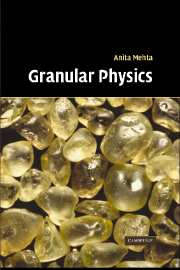Book contents
- Frontmatter
- Contents
- Preface
- 1 Introduction
- 2 Computer simulation approaches – an overview
- 3 Structure of vibrated powders – numerical results
- 4 Collective structures in sand – the phenomenon of bridging
- 5 On angles of repose: bistability and collapse
- 6 Compaction of disordered grains in the jamming limit: sand on random graphs
- 7 Shaking a box of sand I – a simple lattice model
- 8 Shaking a box of sand II – at the jamming limit, when shape matters!
- 9 Avalanches with reorganising grains
- 10 From earthquakes to sandpiles – stick–slip motion
- 11 Coupled continuum equations: the dynamics of sandpile surfaces
- 12 Theory of rapid granular flows
- 13 The thermodynamics of granular materials
- 14 Static properties of granular materials
- References
- Index
- Plate section
10 - From earthquakes to sandpiles – stick–slip motion
Published online by Cambridge University Press: 06 October 2009
- Frontmatter
- Contents
- Preface
- 1 Introduction
- 2 Computer simulation approaches – an overview
- 3 Structure of vibrated powders – numerical results
- 4 Collective structures in sand – the phenomenon of bridging
- 5 On angles of repose: bistability and collapse
- 6 Compaction of disordered grains in the jamming limit: sand on random graphs
- 7 Shaking a box of sand I – a simple lattice model
- 8 Shaking a box of sand II – at the jamming limit, when shape matters!
- 9 Avalanches with reorganising grains
- 10 From earthquakes to sandpiles – stick–slip motion
- 11 Coupled continuum equations: the dynamics of sandpile surfaces
- 12 Theory of rapid granular flows
- 13 The thermodynamics of granular materials
- 14 Static properties of granular materials
- References
- Index
- Plate section
Summary
In this chapter, we seek to explain the nature of experimentally observed avalanche statistics from a more event-based point of view than in the earlier chapter. In some ways, the difference between the two approaches is akin to that between Monte Carlo and molecular dynamics approaches. In the last chapter (as in Monte Carlo simulations), the dynamics is ‘simulated’ – real grains do not, after all, topple as a result of height thresholds – with a view to matching only the end results of, in this case, avalanche statistics. In this chapter, we try to model an (albeit simplified) version of the real dynamics that occurs when grains avalanche. Interestingly, though both approaches are totally different, the results are robustly similar – we find via both approaches the prediction of a special scale for large avalanches, and, in this chapter, propose a dynamical mechanism which leads to their being unleashed.
Avalanches in a rotating cylinder
Here we describe a model of an experimental situation which forms the basis of many traditional as well as modern experiments; a sandpile in a rotating cylinder. Consider the dynamics of sand in a half-cylinder that is rotating slowly around its axis. Supposing that the sand is uniformly distributed in the direction of the axis, we are dealing with an essentially one-dimensional situation. The driving force arising from rotation continually affects the stability of the sand at all positions in the pile and is therefore distinct from random deposition.
- Type
- Chapter
- Information
- Granular Physics , pp. 132 - 147Publisher: Cambridge University PressPrint publication year: 2007



